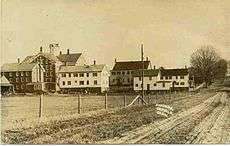Enfield Shakers Historic District (Connecticut)
|
Enfield Shakers Historic District | |
 | |
| Location | Shaker, Taylor and Cybulski Rds., Enfield, Connecticut |
|---|---|
| Area | 110 acres (45 ha) |
| Built | 1827 |
| NRHP Reference # | 79002663[1] |
| Added to NRHP | May 21, 1979 |
| Community | Enfield Shaker Village (Connecticut)[2] |
|---|---|
| Dates | 1792-1917 |
| Bishopric | Hancock |
| Spiritual name | City of Union |
| Families | Church, North, South, East, West |
| Maximum population | 215 in 1850 |
 |
| Topics |
|---|
|
| Notable people |
|
The Enfield Shakers Historic District in Enfield, Connecticut has significance dating to 1827. It was listed as a historic district on the National Register of Historic Places in 1979. The listing included 15 contributing buildings and one contributing site.[1]
It is significant for its association with the Shakers who lived there and for the architecture reflecting their social values and Utopian community lifestyle. The Enfield Shaker community was the only Shaker settlement in Connecticut (others were in Massachusetts, New Hampshire, New York, Indiana, Ohio, Kentucky) and was significant for its garden-seed business. The Enfield settlement lasted until 1917 when the Shakers departed. The district included all 15 buildings that survive, out of about six times as many existing in 1917. In 1978, the surviving buildings include a meetinghouse, a large brick residence, an ice house, five barns, a sawmill, a slaughterhouse, a laundry, and several workshops, in three village-like clusters.[3]
Some or all of the location has since become the Enfield Correctional Institute, a prison.
-

Enfield community, c. 1910
See also
References
- 1 2 National Park Service (2010-07-09). "National Register Information System". National Register of Historic Places. National Park Service.
- ↑ Stephen J. Paterwic. The A to Z of the Shakers. Scarecrow Press; 28 September 2009. ISBN 978-0-8108-7056-7. p. 63.
- ↑ Bruce Clouette (June 21, 1978). "National Register of Historic Places Inventory/Nomination: Enfield Shakers Historic District" (PDF). National Park Service. and accompanying 14 photos from 1976-78